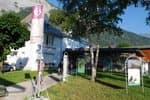
2. From the Muzelle refuge to Bourg d'Arud
Description
Start off by walking round Lake Muzelle anticlockwise then turn onto a path through the mountain pastures, after a section through the scree, followed by a steep climb with small zigzags arriving just below the Col du Vallon. You can admire the Barre des Ecrins, which is seldom seen from this direction, and Lake Muzelle and its refuge. The descent towards Le Lauvitel starts off in an environment scattered with slabs of roches moutonnées (or sheepback), followed by a fine path with lush vegetation overlooking the lake from start to finish. During the descent, you will have to cross the mountain stream a few times and there are a few sections with handrails. At the lake, you can enjoy the “beach" for a rest before finishing the descent towards La Danchère. The path is mainly shaded, but there are sometimes a lot of people. After passing by a water supply point, continue the descent as far as La Danchère (you can take a drinks break in the lovely country gardens), cross the village, pass the hotel and then take the right-hand fork at the chapel, then left at the next intersection. Follow the road for a few dozen metres and then take the path that begins opposite in the bend in the road. After a few metres, turn into a large path on the right, along the powerful River Vénéon, and continue into the forest. At “Parc Aventure", continue straight on as far as the village of L'Alleau and then go down as far as the car park.
- Departure : Muzelle refuge
- Arrival : Bourg d'Arud
- Towns crossed : Les Deux Alpes and Le Bourg-d'Oisans
9 points of interest
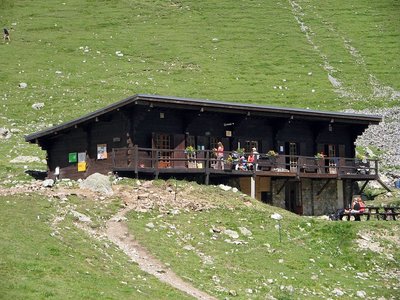
Le refuge de la Muzelle - PNE - Albert Christophe  Hut
HutMuzelle refuge
The bottom of the valley comes up to the rock wall at Muzelle, the pic du Clapier du Peyron and the head of the Muraillette. The modern history of this place is marked by mountaineering. It was on the 2nd July 1875 that Coolidge guided by Almer father and son opened the normal way to Roche de la Muzelle by the East North East face and the North-East ridge.. At this time, even if a pastoral cabin was used by the mountaineers the bivouac was still often used in the Muzelle valley. In 1967, it was in the rocky cirque that the community built the refuge on the shore of Muzelle lake.
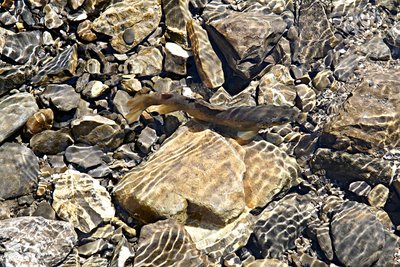
La truite fario - PNE - Telmon Jean-Philippe  Lake
LakeLac de la Muzelle
The Lac de la Muzelle is a glacier lake with cold waters, poor in life. The fish population is limited to salmonids (Arctic char, brook trout, etc.). Their active period is limited to summer. Since their food sources are low, they suffer from dwarfism. Each year, scientific monitoring is carried out by various universities and the National Park: samples of fish, phytoplankton, zooplankton and physical measurements.
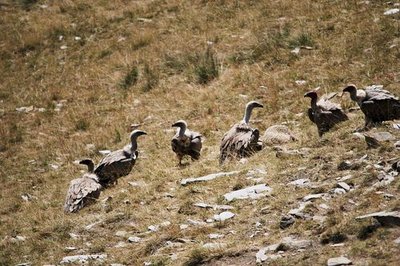
Vautours fauves - Marion Molina  Fauna
FaunaGriffon vultures
From the Col du Vallon, you can sometimes see griffon vultures. The bird returned to the mountains a few years ago. Bigger than an eagle, with beige and brown plumage, it generally glides in flight, and its movements are broad and slow. But what characterises the species above all is its gregariousness: griffon vultures like to be together, whether on the ground or in the air. This behavioural adaptation makes it easier for them to find the animal carcasses they feed on.
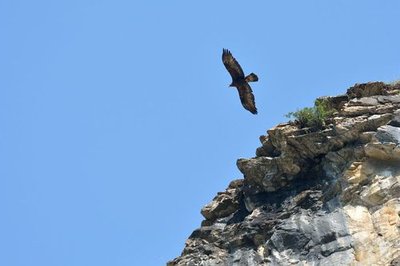
Aigle royal en vol - Mireille Coulon - PNE  Fauna
FaunaGolden eagles
Several birds of prey cross the skies above L’Oisans. Among them are two couples of golden eagles that share the Muzelle and Lauvitel valleys. They have an impressive wingspan (2.30 m on average), are mostly brown colour, and often hunt marmots at low altitude.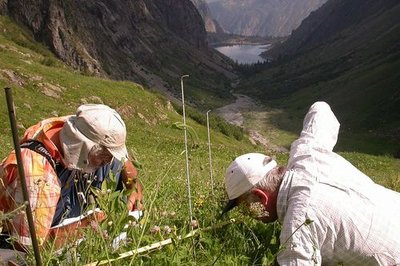
Réserve intégrale du Lauvitel, relevé des lignes de lecture de la végétation - Denis Fiat - PNE  Flora
FloraRéserve intégrale du Lauvitel
The Lauvitel full reserve area was created on 9 May 1995, and is a first in France in a National Park. It lies at the end of the valley and has been owned by the state since 1980. This area, where all human activity is forbidden, is a site for scientific observation of an environment over the long term. Vegetation, animals, water and climate are studied and compared with the data from other sites. Access to the reserve is strictly forbidden except for scientific purposes.
Marmotte sur son terrier - Mireille Coulon - PNE  Fauna
FaunaMarmots
The marmots are some of the permanent inhabitants of the grassland at the alpine level. . The view is very open, the herbaceous food is abundant and the soil sufficiently soft for them to be able to dig their burrows which are necessary for their survival. Although this animal is wild animal, it can become accustomed to the presence of humans and some marmots have started the bad habit of begging for pieces of biscuit from hikers, crisps and apples. Please do not feed them ! These foods, which are unsuitable to their needs, damage their health and survival. Would you think of eating grass in order to survive?

Pavage sur le sentier du Lauvitel - Cyril Coursier - PNE  Know-how
Know-howTraditional Paving
The Lauvitel path is often used especially during the summer. To limit the occurrence of erosion linked to the impact of human use but also to water flowing from melting ice or rain water it is covered with traditional paving, maintained thanks to annual restoration.

Le hameau de la Danchère - PNE  Architecture
ArchitectureDanchère Hamlet
With its paved lanes, its fountains and its stone wash-house, the Danchère offers an ideal starting point for going to Lauvitel which attracts 30 000 visitors every year. It is one of the numerous hamlets that make up the commune of Vénosc.
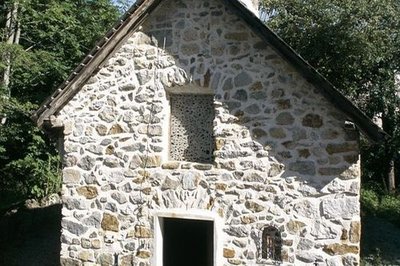
Les décharges de la chapelle de la Danchère - Cyril Coursier - PNE  Architecture
ArchitectureDanchère Chapel
Dedicated to Saint Louis and to Saint Claude, Danchère Chapel displays its agreeable proportions to visitors. The stones forming the arc of a circle above the entrance and the window do not only have aesthetic value. They are rightly called "a relieving structure" because they help to redistribute the weight of the facade on both sides of the openings. In the recess hidden behind wire netting is a ceramic statue of Saint Louis created in the Tarn region.
Altimetric profile
Sensitive areas
- Impacted practices:
- Aerial, Aquatic, Land, Vertical
- Sensitivity periods:
- JanFebMarAprMayJunJulAugSepOctNovDec
- Contact:
- Parc national des Écrins.
Golden eagle
- Impacted practices:
- Aerial, , Vertical
- Sensitivity periods:
- JanFebMarAprMayJunJulAug
- Contact:
- Parc National des Écrins
Julien Charron
julien.charron@ecrins-parcnational.fr
Golden eagle
- Impacted practices:
- Aerial, , Vertical
- Sensitivity periods:
- JanFebMarAprMayJunJulAug
- Contact:
- Parc National des Écrins
Julien Charron
julien.charron@ecrins-parcnational.fr
Peregrine falcon
- Impacted practices:
- Aerial, Vertical
- Sensitivity periods:
- FebMarAprMayJun
- Contact:
- Parc National des Écrins
Julien Charron
julien.charron@ecrins-parcnational.fr
Short-toed snake eagle
- Impacted practices:
- Aerial,
- Sensitivity periods:
- MarAprMayJunJulAugSep
- Contact:
- Parc National des Écrins
Julien Charron
julien.charron@ecrins-parcnational.fr
Information desks
Oisans Park house
Rue Gambetta, 38520 Le Bourg d'Oisans
Video presentation of the natural resources of the Oisans mountain and its crafts. Information, documentation about the Park, projections, reading space for children. Accessible to people with reduced mobility. Free admission. All animations of the Park are free unless otherwise stated.
Source

Report a problem or an error
If you have found an error on this page or if you have noticed any problems during your hike, please report them to us here:


